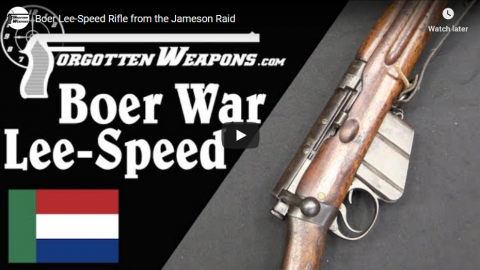Forgotten Weapons
Published on 29 Aug 2019The Jameson Raid in December 1895 was one of the key events in the lead to the second Boer War. Leander Jameson took a force of about 600 men on December 1895 to make a surprise attach on Johannesburg, incite support for the multitude of British miners who felt oppressed by the Boer government, and ultimately bring in British forces to take over. The plan failed in a complete and public manner, though, as Boer forces knew about it from the very beginning. The raiding party was ambushed at Doornkop outside Johannesburg and forced to surrender. It was a tremendous public relations setback for supporters of British intervention.
In addition, the Boers captured a nice selection of very modern arms, including half a dozen artillery pieces, a dozen Maxim machine guns, and about 500 Lee rifles. This Lee-Speed is one of them, given to a Boer burgher who used it in the war that eventually broke out in 1899. He carved his name into the stock, as was common for the Boers. This is one of only two known and documented surviving rifles from the Jameson Raid, and it is both a very cool piece of history for that reason as well as a great time capsule of the Lee-Metford MkI pattern of rifle. Most of the early Lees in British military service were updated and repurposed over the decades, and finding them in original configuration is quite difficult today.
http://www.patreon.com/ForgottenWeapons
Cool Forgotten Weapons merch! http://shop.bbtv.com/collections/forg…
Contact:
Forgotten Weapons
PO Box 87647
Tucson, AZ 85754
November 7, 2019
Boer Lee-Speed Rifle from the Jameson Raid
January 25, 2019
The Royal Canadian Regiment and The Battle of Paardeberg
The History Guy: History Deserves to Be Remembered
Published on 1 Jan 2019The forgotten history of a storied regiment. This is the second episode of a special holiday series featuring the History Guy’s hat collection. It was originally made as exclusive content for the channel’s patrons on Patreon. You can get exclusive content too by giving as little as one dollar a month to The History Guy at https://www.patreon.com/TheHistoryGuy.
This is original content based on research by The History Guy. Images in the Public Domain are carefully selected and provide illustration. As images of actual events are sometimes not available, images of similar objects and events are used for illustration.
All events are portrayed in historical context and for educational purposes. Those who do not learn from history are doomed to repeat it.
he History Guy: History Deserves to Be Remembered is the place to find short snippets of forgotten history from five to fifteen minutes long. If you like history too, this is the channel for you.
September 23, 2017
The Very First Troop Trials SMLE Rifles
Published on 4 Apr 2017
1902 A Pattern: Sold for $31,625 – http://jamesdjulia.com/item/1647-396/
1902 B Pattern: Sold for $31,625 – http://jamesdjulia.com/item/1648-396/One of the British lessons from the Boer War was that the distinction between infantry rifles and cavalry carbines was becoming obsolete. In 1902, they would initiate troop trials on a new short rifle pattern, intermediate in length between the old rifles and carbines, and intended to be issued universally to all troops. This would become the much-loved SMLE – Short, Magazine, Lee Enfield rifle – but first a few choices had to be made.
The 1902 trials rifles were a bit remarkable in being widely liked by the different troops that used them – only a few changes were to be made before formal adoption took place. However, there were two different patterns of the trials rifles, with different models of rear sight. The B pattern used a friction-locked range adjuster, which was found to migrate during firing (not good). The A pattern had a much more secure set of spring loaded locking notched, and would be chosen as the better of the two.
Despite a thousand of these rifles being produced for the trials, these two are the only known surviving examples. The remainder were converted to .22 caliber training guns around 1907, as their non-standard nature made them unsuitable for issue after the formal adoption of the SMLE MkI (later to be retroactively redesignated the Rifle No1 MkI.
June 27, 2017
Armoured Trains of World War 1 I THE GREAT WAR Special feat. Military History Visualized
Published on 26 Jun 2017
Check out Military History Visualized and his video on armoured trains: https://www.youtube.com/watch?v=dvHTR-5n2_E
Armoured Trains were heavily armed and armored trains operating the vast rail networks of Europe, especially on the Eastern Front of World War 1. Their tactics and design evolved considerably during the First World War and the later Russian Civil War. From rather improvised locomotives to sophisticated designs specially built for combat purposes.
June 13, 2015
South Africa in WW1 I THE GREAT WAR Special feat. Extra Credits
Published on 6 Jun 2015
Check out the Extra Credits Series on the native history of South Africa right here: https://www.youtube.com/watch?v=BZLGK…
The history of South Africa was already influenced by ethnic tension between the natives and the recently arrived colonists from Great Britain and the Netherlands. The Boers had actually fought to wars with the Empire for self determination. Still, in World War 1 they fought for the King. South Africa saw major action in German East Africa against Paul von Lettow-Vorbeck. But their troops were tested in Europe as well. For example in Delville Woods too where they fiercely fought agains the attacking German Army.




